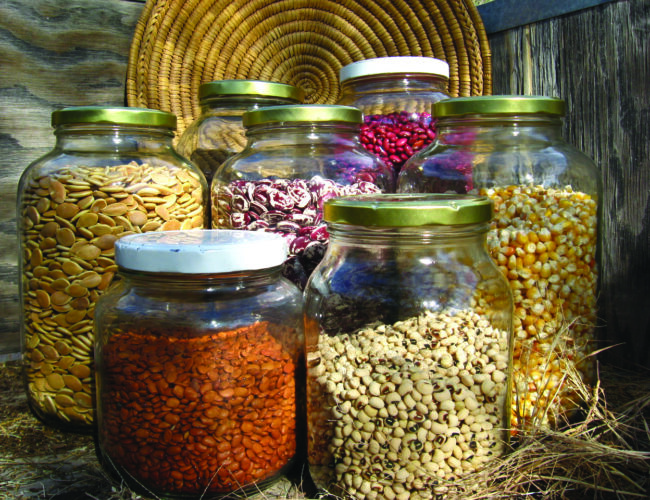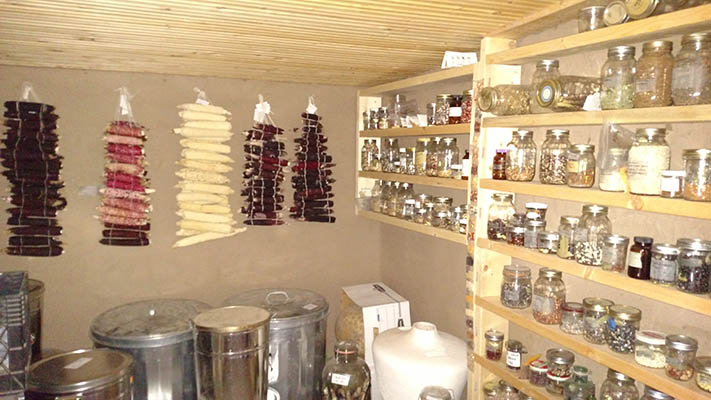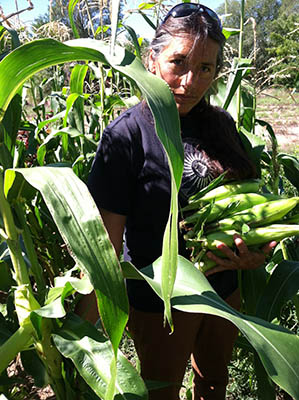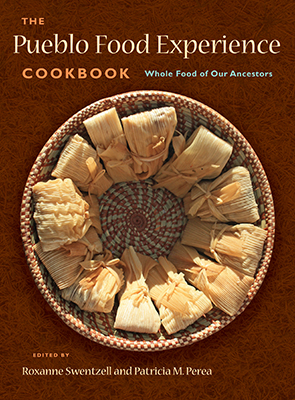Turning Toward the Taproot
Small, yet mighty indigenous seeds are restoring pueblo culture and health.
BY EMILY WITHNAL
Roxanne Swentzell’s kitchen does not have a refrigerator. Instead, books and large glass jars line wooden shelves. The jars are filled with dried beans, many varieties of corn, dried wild spinach, currants, pumpkin seeds, and grasshopper flour.
A bicycle flour grinder sits in the center of the large, open kitchen. Its chain connects to the mill’s flywheel that, once in motion, grinds corn or other grain. The mill rests on a small kitchen island, the hopper heaped with freshly ground cornmeal. Rows of small mason jars crowd the rest of the island, popping periodically as the jars seal.
Roxanne’s kitchen is as much a place of experimentation as the rest of her home, where three-dimensional faces protrude from wood cabinets, and in the living room, the carved stone bodies of nude women emerge from the adobe walls. They appear to be on the verge of stepping out of the walls to join the conversation. Her adobe home is surrounded by more of her sculptures and a small forest of piñon, peach, and apricot trees. When she moved back to Santa Clara Pueblo in 1989, however, she says, “There was nothing here but ants.”
She comes from a long line of artists at Santa Clara. Her sculptures fill Tower Gallery, her own gallery in Pojoaque, and her work is represented in galleries and museums throughout New Mexico, the United States, and overseas. The creativity that drives her art also fueled her desire to try to grow a sustainable forest system in the high mountain desert. Her thirty-year experiment with various aspects of permaculture—a whole-systems gardening technique that mimics the natural design of a self-sustaining ecosystem—led her to what she calls the Pueblo Food Experience. It was her experiment to get to the bottom of a burning question: What would happen if we ate only what our ancestors ate?
Five years later, Roxanne is still uncovering answers, and has co-edited a corresponding cookbook with Patricia M. Perea, The Pueblo Food Experience Cookbook (Museum of New Mexico Press, 2016) describing her journey, and the foods she discovered during her experiment.
It all began in 1989, when Roxanne, her then-husband, Joel Glanzberg, and their friend Brett Bakker decided they wanted to find out if they could feed themselves entirely off an eighth of an acre. It’s the same land Roxanne’s home occupies now. And so they founded the Flowering Permaculture Tree Institute.
“It was an experiment of sorts,” says Roxanne. “Nobody that we knew of had done that in this kind of climate.” Roxanne, Joel, and Brett began recording their experiments with growing food, building adobe houses and hornos, and raising animals like sheep, chickens, and turkeys. Beginning in 1994, they shared their discoveries in a handwritten, photocopied newsletter. They also began to offer workshops to Santa Clara Pueblo community members who wanted to learn about things like farming, land restoration, and water harvesting. “We were an oddity,” Roxanne laughs. “Most people were looking at us and asking, ‘What are you doing?’”
At the same time, she began collecting and saving any seeds she could get her hands on. When a few kids at San Juan Pueblo accidentally burned the seed bank down, she asked for some of the salvaged seeds and began to plant them to ensure their continued survival by collecting and saving more seeds from the mature plants. Roxanne also reached out to other tribes, seeking different types of corn, squash, and other crops no longer available at Santa Clara. “Some of it I got from the Hispanic community,” she says. “They’d gotten their seeds from the Pueblos and kept those species alive when the Pueblos lost them.”
Roxanne’s motivation to save seeds followed a trend across the Pueblos. Everywhere, farmers were aging and Native youth showed little interest in seed saving or farming. The elders and farmers of each community had the knowledge and seeds but often had no one to pass their seeds down to. Following a conference in Gallup in 1992, organized by Arizona-based Native Seeds/SEARCH, these concerns led to the formation of the Traditional Native American Farmers Association (TNAFA). TNAFA is an affiliate of the Seventh Generation Fund for American Indians and is made up of fifty families from eighteen New Mexico tribes. Since their formation in Gallup they have offered workshops every year to teach tribal youth the importance of their traditional seed saving and agricultural practices.
TNAFA Program Director Clayton Brascoupe, of Tesuque Pueblo, forges partnerships with other Native communities, advocates for policies at the local, regional, and national levels, and coordinates farming workshops in various locations across northern New Mexico. Interest in farming and seed saving from teens and young adults at Tesuque Pueblo is no longer a worry since they now make up eighty percent of farming workshops. Now, the Pueblo wants to strengthen the links between generations by recruiting more participants of all ages to create essential connections for all tribal members. “When an Elder dies it’s like losing a reference library,” says the former executive director of Native Seeds/SEARCH, Angelo Joaquin.
Like Roxanne and Clayton, Beata Tsosie Peña is working to recover old seeds and knowledge. Beata is from Santa Clara Pueblo and serves as the Environmental Health and Justice coordinator for Tewa Women United, an organization dedicated to ending violence against women, girls, and Mother Earth. When the Spanish brought wheat to the New World, it gradually replaced crops that indigenous people relied on for food and ceremony, including amaranth. The wild variety is commonly known as pigweed. “We have a big focus on amaranth right now,” Beata says, referring to Tewa Women United’s partnership with the Española Healing Oasis. “We do cultural exchanges with farmers from Guatemala every year and they come and teach us how to harvest and cook with it.”
A one-quart jar rests on the table in the Tewa Women United’s kitchen in Española. The jar is filled with amaranth seeds culled from eight flower heads. The seeds are round and tan and resemble tiny versions of quinoa seeds. Knowing where food will be coming from next year or in seven years’ time can be hard to predict in light of burgeoning populations, climate change, and the threats that genetically modified organism (GMO) crops pose to indigenous seeds. Though agricultural corporations like Monsanto frequently tout GMO crops as the solution to world hunger, drought and pests continue to wipe out them out. Indigenous seeds, on the other hand, tend to survive, with a resilience developed over centuries of adaptation to their landscape and a genetic diversity that allows some plants to thrive even if others are wiped out.
“What’s driving Monsanto nuts right now is what they call a ‘super weed,’—but it’s actually amaranth,” Beata laughs. “It’s the only ‘weed’ that isn’t getting killed by Roundup.”
Amaranth greens can be cooked like spinach. Its seeds can be ground into flour and used in atole and other Native recipes. The grain from mature plants is a so-called superfood because it is a complete protein and contains B-complex vitamins. And, like other indigenous crops, amaranth’s resilience makes it much better suited to withstanding the erratic weather conditions that climate change has provoked.
“Amaranth could replace all these GMO cornfields and feed the world,” Beata says. “If we just listened and paid attention to what the plants are telling us, we would have our solutions.”
The Pueblo Food Experience was sparked in 2012 when Porter Swentzell, Roxanne’s son, visited his doctor. In his mid-twenties, he was obese and headed for a heart attack. And at age six, Roxanne’s second youngest grandchild received a diagnosis of pre-diabetes. As is the case across the United States, Native Americans in New Mexico face a disproportionate risk for diabetes, death from diabetes, obesity, high cholesterol, and high blood pressure.
As a historian, Porter became curious about what their pueblo ancestors ate and decided to try eating pre-Spanish-contact foods as much as possible. He lost weight and gained energy within a month, excited about getting healthier and reconnecting with his roots. Roxanne was excited, too. She reached out to twelve other members of Santa Clara Pueblo ranging from six to sixty-five, all of whom agreed to join her in an experiment that she called the Pueblo Food Experience. For this experiment, the fourteen group members agreed to eat a diet of pre-contact food for three months.
To begin, each member received blood tests and health assessments. “We all came home depressed,” Roxanne says.
It was rough going initially, as they quit sugar, wheat, coffee, alcohol, chicken, beef, pork, and dairy at once. They met regularly every week or two for potlucks to share recipes and food, offering one another moral support to avoid temptation. They experimented with traditional foods by inventing new processing and cooking techniques and tracked down old recipes.
One recipe, included in the Pueblo Food Experience Cookbook, is for buwah, which calls for cornmeal, ashes, water, and mashed brains (from any of the pre-contact animals listed among the cookbook’s “Food List”). “The Hopis call it piki and we call it buwah, but it had been long forgotten,” Roxanne says. “My grandparents didn’t make it, but some of us had our families’ cooking stones. And some of the Hopi women still make it, so we brought them over to help us and learn these methods again.”
Despite the surprising ingredients, buwah is tasty, and the dancers at Santa Clara have begun to request it for their traditional ceremonies. “It tastes wonderful, like crunchy, light, smooth corn flakes,” says Roxanne. “Part of the fun of eating buwah is the way it falls apart in your mouth as it dissolves quickly with moisture.”
At the end of three months, the group’s members went for a follow-up medical exam. Their doctors were astounded. Two people had lost over fifty pounds each, one woman with severe arthritis could close her hands fully again, and each had far more energy than before. Other community members wanted their secrets, prompting Roxanne to create the Pueblo Food Experience Cookbook, which is filled with essays about their experiences and recipes for foods including corn tortillas, squash chips, turkey tomatillo tamales, and buffalo tongue.
It’s healthy, and therefore tempting to others, but Roxanne says there is danger in people outside the Pueblos wanting to commercialize indigenous plants and recipes.
“It’s not the ‘cool diet’ to be on; it’s about cultural identity,” she says. “The Pueblo Food Experience wasn’t meant to say, ‘Everyone eat this way.’ No, find your original food because it might really do something for your health and your identity.”
She is excited by the prospect of people from other cultures trying their own “hardcore” versions of the Pueblo Food Experience, exclusively eating their own traditional foods. She wants to find out if their results are comparable, because she believes that the foods that are best for us are matched to our DNA. Admittedly, this is complicated for people who don’t know their ancestry, or who have a large mix of ancestries. And although she worries about the commercialization of Native cultural heritage, Roxanne sees her experiment as being valuable for everyone.
Helping to restore native plants is one way to connect with the landscape and eat in a healthier way. “Grow a forest of indigenous plants that are edible,” Roxanne says. “Grow your own piñon and currant trees. Make your yard a source of food and beauty.”
Angelo Joaquin favors white bawi beans, but lauds the health benefits of all beans. In his time working for Native Seeds/SEARCH, Joaquin was in charge of their diabetes project, which helped to educate people about how to avoid or manage diabetes. A bean’s seed coat contains pectin, which, once ingested, takes a long time to break down. “What happens is that it lets sugar into your blood at an even rate, so you don’t get a spike,” says Joaquin. “If the pancreas is still operating, it can process the amount of sugar that comes in.” And because smaller beans have a higher percentage of seed coat, bawi beans—as opposed to pinto beans—pack more of a pectin punch.
While some seeds remain difficult to find, seed saving and trading has become easier in northern New Mexico. Understanding the need for seed protection and the preservation of land-based practices, the New Mexico Food and Seed Sovereignty Alliance (NMFSSA)—made up of Tewa Women United, TNAFA, Honor Our Pueblo Existence, and the New Mexico Acequia Association (NMAA)—started the Ówîngeh Tá Pueblos y Semillas Gathering and Seed Exchange in 2006. The gathering occurs every spring, and is hosted in alternate years by pueblo and acequia communities.
“It’s a beautiful event, because it brings both cultures together around shared values about land, earth, and water,” Beata says. The seed exchange begins with blessings by the Tewa community and the Los Hermanos Penitentes, and demonstrates both communities’ “love and care for the land and each other.” In addition to providing a place for people to exchange seeds, farmers and seed savers from across northern New Mexico give presentations and workshops on cultivation strategies and seed protection.
Flowering Tree Permaculture Institute started as a large nonprofit dedicated to big permaculture ideas, but Roxanne says, “it swirled itself to really focus on this particular place.” When she and others who participated in the Pueblo Food Experience assembled their cooking stones to learn to make buwah, they realized they needed a place to keep them so they could grind corn together. This led to a community building project where kids and volunteers from Santa Clara showed up once or twice a week to mix mud and make adobe bricks. Two years later, women gather in the new cooking house to grind corn and perfect their buwah-making skills.
“Now we have a place that the farmers are coming to and saying, ‘What do you need us to grow?’ So we can say, ‘We need blue corn for our buwah,’ or ‘We need this squash,’ and they grow it,” says Roxanne. “And then they call us, and say, ‘Come help hoe,’ or ‘Come help pick it,’ and this brings the community together again in a really wonderful way. Then that produce can come to our building, that we built, to be redistributed to families.”
Mutual support, community, and cultural pride made the Pueblo Food Experience successful. Roxanne says she realized the day they had turned a corner as a group. “One of the older women called me saying, ‘I’m in front of Burger King in Española.’”
“I told her, ‘Marian, don’t! You can be strong. I know it smells good, but don’t go in!’”
“She said, ‘Shut up! There’s some ripe cactus fruit in front of their building.’ And I just laughed because I thought, we have done it, we have gone past the point where we see Burger King as food. Now we’re looking at their landscaping for food.”
Born and raised in New Mexico, Emily Withnall currently lives in Missoula, Montana, where she works as a poetry instructor and freelance writer.




